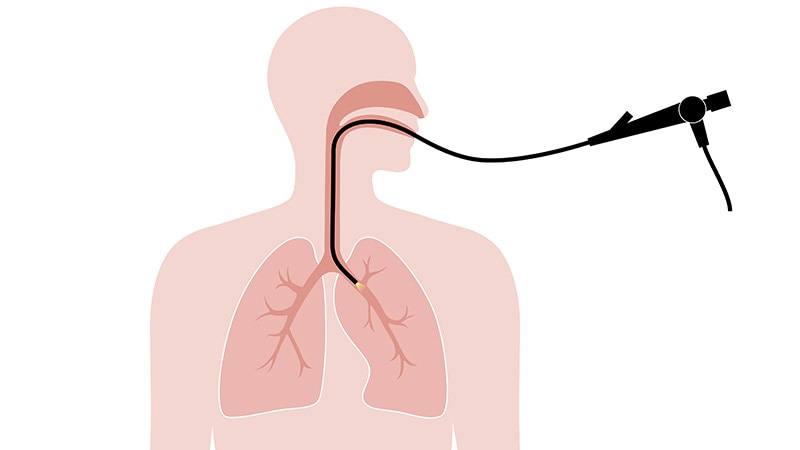Artificial Intelligence Enhances Pulmonology Imaging and Prognosis: Advancements in Endoscopic Techniques and Challenges in Managing Pneumonitis
Główne pojęcia
Artificial intelligence (AI) is transforming pulmonology imaging and prognosis, enabling enhanced characterization of lung lesions, improved diagnostic techniques, and better patient assessment, but challenges remain in managing pneumonitis in oncology patients.
Streszczenie
The content discusses how AI is changing the field of pulmonology, particularly in the areas of endoscopic imaging and diagnosis. Key points:
- AI can enhance endobronchial ultrasound (EBUS) image processing and new techniques like cryoEBUS, leading to significant diagnostic and prognostic breakthroughs in interventional pulmonology.
- The field of radiomics, a branch of AI, can facilitate the characterization of lung lesions and potentially aid in future histological differentiation or molecular marker assessment.
- Electromagnetic navigation bronchoscopy allows access to peripheral lung lesions, and studies like NAVIGATE have confirmed its diagnostic capabilities and performance.
- Challenges remain in diagnosing non-solid lung lesions (ground glass opacities) and determining the most cost-effective techniques for different types of lung nodules.
- Improvements in echobronchoscopy technology, including high-quality image processors and smaller device calibers, have enhanced the diagnosis of lesions and hard-to-reach adenopathies.
- The use of small-caliber cryoprobes (cryoEBUS) has improved diagnosis by enabling larger tissue samples, which is particularly useful for pathologies requiring extensive molecular and immunohistochemical studies.
- Liquid biopsy, a recent laboratory technology, allows the analysis of blood/pleural fluid samples to differentiate between malignancy and benignity.
- Pulmonologists face the challenge of managing pneumonitis, a common side effect of oncological treatments, as there is currently no alternative treatment apart from corticosteroids, and the optimal tapering of doses is uncertain.
Customize Summary
Rewrite with AI
Generate Citations
Translate Source
To Another Language
Generate MindMap
from source content
Visit Source
www.medscape.com
AI Is Changing Pulmonological Imaging and Prognosis
Statystyki
"Pneumonitis is an inflammation of the lungs that can be secondary to treatments, such as oncological therapy, which is the leading cause in 15%-50% of cases."
"Patients with interstitial lung disease and pulmonary fibrosis have been found to have a higher mortality risk due to pneumonitis."
Cytaty
"AI in interventional pulmonology will be highly beneficial in image interpretation and patient assessment for those who require more invasive diagnostic techniques or for follow-up."
"The use of AI without a specific goal, that is, creating a mathematical algorithm and feeding it with clinical patient data without control and validation, can lead to inaccurate conclusions."
"Suspending oncological treatment due to pneumonitis means that patients are not receiving adequate cancer treatment, which has a significant psychological impact that also needs to be addressed."
Kluczowe wnioski z
by Dr. Javier C... o www.medscape.com 05-21-2024
https://www.medscape.com/viewarticle/ai-changing-pulmonological-imaging-and-prognosis-2024a10009l3
Głębsze pytania
How can the ethical and legal considerations surrounding the use of AI in pulmonology be addressed to ensure patient privacy and data security?
In order to address the ethical and legal considerations related to the use of AI in pulmonology and ensure patient privacy and data security, several measures can be implemented. Firstly, it is crucial to establish clear guidelines and regulations regarding the collection, storage, and sharing of patient data. This includes obtaining informed consent from patients for the use of their data in AI algorithms and ensuring that data is anonymized to protect patient identities. Additionally, healthcare providers should prioritize data encryption and secure storage methods to prevent unauthorized access.
Furthermore, ongoing training and education for healthcare professionals on the ethical use of AI in pulmonology are essential. This includes understanding the limitations of AI algorithms, interpreting their results accurately, and ensuring that decisions based on AI recommendations are always validated by clinical expertise. Collaboration with legal experts to develop robust data protection policies and protocols can also help in safeguarding patient information.
What alternative treatments or management strategies could be explored to address the challenge of pneumonitis in oncology patients beyond the use of corticosteroids?
Beyond the use of corticosteroids, alternative treatments and management strategies for pneumonitis in oncology patients can be explored to improve outcomes and reduce the risk of reinflammation. One approach is the use of immunosuppressive agents, such as tacrolimus or mycophenolate mofetil, which have shown efficacy in some cases of drug-induced pneumonitis. These medications can help modulate the immune response and reduce inflammation in the lungs.
Another strategy is the implementation of supportive care measures, including oxygen therapy, pulmonary rehabilitation, and close monitoring of lung function. These interventions can help alleviate symptoms, improve lung capacity, and enhance overall quality of life for patients with pneumonitis. Additionally, targeted therapies that specifically address the underlying cause of pneumonitis, such as discontinuing the offending medication or adjusting the dosage, should be considered to prevent recurrence.
What potential synergies or complementary roles could exist between AI-powered diagnostic techniques and traditional pulmonology practices to optimize patient outcomes?
The integration of AI-powered diagnostic techniques with traditional pulmonology practices can lead to synergies that optimize patient outcomes through enhanced accuracy, efficiency, and personalized treatment approaches. AI algorithms can assist pulmonologists in interpreting complex imaging data, such as CT scans or bronchoscopy images, to identify lung lesions, differentiate between benign and malignant nodules, and predict prognosis more accurately.
Moreover, AI can facilitate the early detection of lung diseases, enabling timely interventions and personalized treatment plans tailored to individual patient needs. By combining AI insights with clinical expertise, pulmonologists can make more informed decisions, prioritize high-risk patients for further evaluation, and monitor disease progression more effectively. This collaborative approach can lead to improved diagnostic accuracy, reduced treatment delays, and ultimately better outcomes for patients with pulmonary conditions.
0
